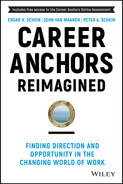Introduction: Plan for This Book
Dr Seuss:
“You have brains in your head
You have feet in your shoes,
You can steer yourself
Any direction you choose”
We start with the timeless inspiration of Dr. Seuss, Theodore Geisel, from his playful yet profound “career” book Oh, the Places You'll Go (Seuss, 1990; New York: Random House). Each chapter except the last will start with an excerpt from Dr. Seuss to help set the table and remind us of the ups and downs of career journeys.
Our goal is to provide you an opportunity to think about your work life and your relationships as you look ahead into a post‐pandemic, environmentally challenged new world. We believe that you need to do this thinking because things are dramatically different now as the next chapter will highlight.
We have organized the material for you to analyze your situation and to enable you to identify choices that you may already have made or that will soon be forced upon you by the rapidly evolving economic, social, political, and climate challenges that are all around us and are picking up speed.
Chapter One highlights many of those changes to help you think which of them you have observed and which of them have especially affected you.
Chapter Two asks you to do a deep dive into your various relationships at work, at home, and in your overall life. We will ask you to identify whom you relate to and how deep those various relationships are now and possibly need to be in the future. This will enable a new and more refined view of how you see yourself in relation to work, to family and friends, and to your own self‐development. This builds on what in previous editions was called “Job Role Analysis.”
Chapter Three reviews our model of the career as having an external meaning in terms of the formal or expected steps needed to succeed in a given occupation which we called the “external career.” We differentiate this external career from how you learn from your various job experiences what are your competencies, motives, and values. This becomes akin to your self‐image or work identity and represents your “internal career.”
Chapter Four describes the eight career anchors, which make up some of the main components of that internal career. You are invited to begin to think about how well any of them fit you now or depict where you want to go as you look ahead. To help you do this we provide both formal descriptions and case examples of each anchor.
Chapter Five continues the deep dive into your internal career by asking you to review your job history, in an “interview,” preferably with a friend or partner, to analyze how your internal career developed and shaped itself in terms of the various possible anchor categories.
Chapter Six then takes you online and provides you with a 32‐item survey that asks you to think about past and future choices and shows you on a “spiderweb” chart your own biases and preferences for the different anchor categories.
Chapter Seven will lead you to a new set of items with which you can identify possible areas of growth as you look ahead into this VUCAA world in terms of the same “spiderweb” chart. This analysis will lead you to a new set of actions based on the confidence that you now know better who you are and what you need to do next.
Chapter Eight presents five detailed Career Anchors and Growth Intentions stories, which include completed charts that show the growth intentions alongside the career anchors. These stories highlight the complexities of what you now face and how five career seekers have set their courses in these challenging conditions.
In Chapter Nine we conclude with a step back and reflection on the choices we make along the way.
The Appendix and Bibliography link this edition to the vast literature of research and practice on careers that has arisen in the last fifty years. In the Appendix, we compare Career Anchors as a concept with two other very popular career concepts, the CliftonStrengths Assessment and the Myers‐Briggs Type Indicator (MBTI) to show both the similarities in these approaches and also to highlight the differences. In the Bibliography, we provide the reader who wants to know more about the research base for this work and what else to read with an extensive list of other publications bearing on mid‐life career issues and changes in our work and organizational worlds.
The main body of the text is designed to GET YOU DIRECTLY INVOLVED in thinking about your work and your relationships in this turbulent post‐pandemic time—What is happening out there, what is your situation now, and, as you look ahead, what choices confront you?
A Cautionary Note:
